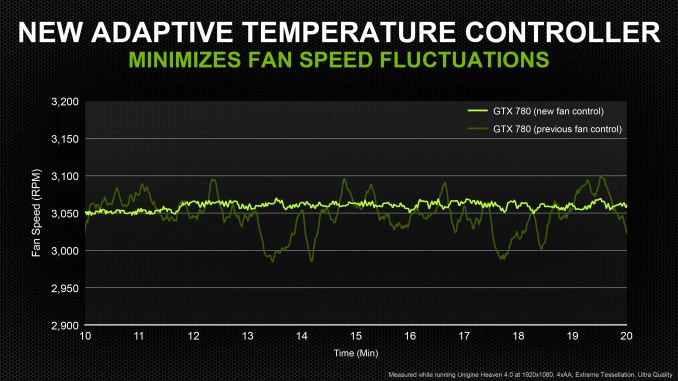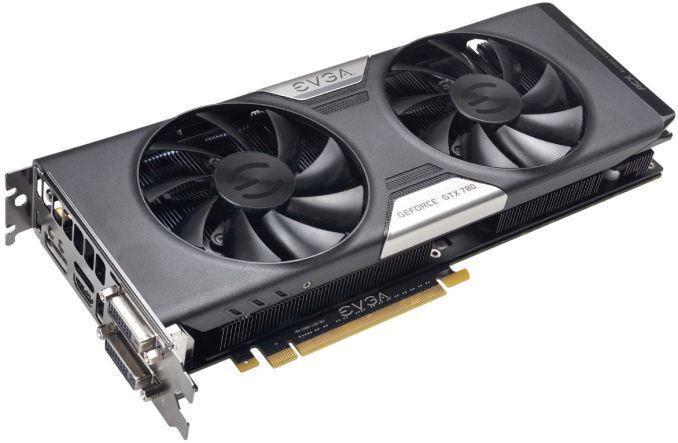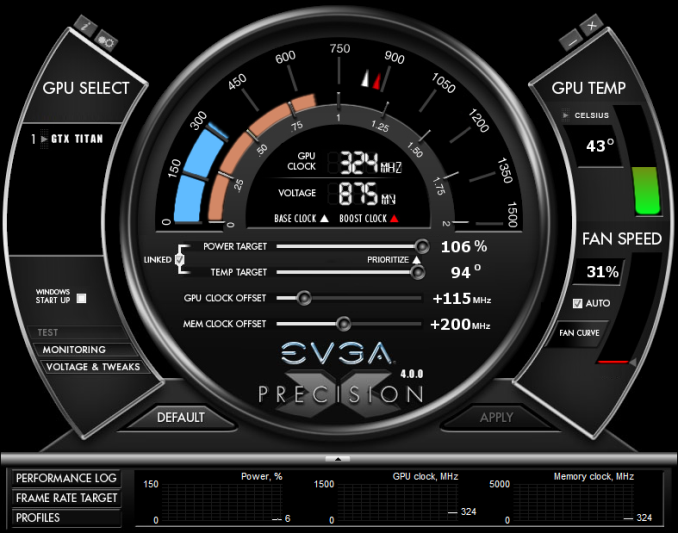NVIDIA GeForce GTX 780 Review: The New High End
by Ryan Smith on May 23, 2013 9:00 AM ESTMeet The GeForce GTX 780, Cont
With all of that said, GTX 780 does make one notable deviation from GTX Titan. NVIDIA has changed their stock fan programming for GTX 780, essentially slowing down the fan response time to even out fluctuations in fan speeds. NVIDIA has told us that they’ve found that next to loud fans in general, the second most important factor in fan noise becoming noticeable is rapidly changing fan speeds, with the changing pitch and volume drawing attention to the card. Slowing down the response time in turn will in theory keep the fan speed from spiking so much, or quickly dropping (i.e. loading screen) only to have to immediately jump back up again.
In our experience fan response times haven’t been an issue with Titan or past NVIDIA cards, and we’d be hard pressed to tell the difference between GTX 780 and Titan. With that said there’s nothing to lose from this change, GTX 780 doesn’t seem to be in any way worse for it, so in our eyes there’s no reason for NVIDIA not to go ahead with the change.
On that note, since this is purely a software(BIOS) change, we asked NVIDIA about whether this could be backported to the hardware equivalent Titan. The answer is fundamentally yes, but because NVIDIA doesn’t have a backup BIOS system, they aren’t keen on using BIOS flashing any more than necessary. So an official (or even unofficial) update from NVIDIA is unlikely, but given the user community’s adept BIOS modding skills it’s always possible a 3rd party could accomplish this on their own.
Moving on, unlike Titan and GTX 690, NVIDIA will be allowing partners to customize GTX 780, making this the first line of GK110 cards to allow customization. Potential buyers that were for whatever reason disinterested in Titan due to its blower will find that NVIDIA’s partners are already putting together more traditional open air cooler coolers for GTX 780. We can’t share any data about them yet – today is all about the reference card – but we already have one such card in-hand with EVGA’s GeForce GTX 780 ACX.
The reference GTX 780 sets a very high bar in terms of build quality and performance, so it will be interesting to see what NVIDIA’s partners can come up with. With NVIDIA testing and approving all designs under their Greenlight program, all custom cards have to meet or beat NVIDIA’s reference card in factors such as noise and power delivery, which for GTX 780 will not be an easy feat. However because of this requirement it means NVIDIA’s partners can deviate from NVIDIA’s reference design without buyers needing to be concerned that custom cards are significantly worse than then reference cards, something that benefits NVIDIA’s partners by their being able to attest to the quality of their products (“it got through Greenlight”), and benefitting buyers by letting them know they’re getting something that will be as good as the reference GTX 780, regardless of the specific make or model.
On that note, since we’re talking about card construction let’s quickly dive into overclocking. Overclocking is essentially unchanged from GTX Titan, especially since everything so far is using the reference PCB. The maximum power target remains at 106% (265W) and the maximum temperature target remains at 95C. Buyers will be able to adjust these as they please through Precision X and other tools, but no more than they already could on Titan, which means overclocking is fairly locked down.
Overvolting is also supported in a Titan-like manner, and once again is at the discretion of the card’s partner. By default GTX 780 has a maximum voltage of 1.1625v, with approved overvolting allowing the card to be pushed to 1.2v. This comes in the form of higher boost bins, so enabling overvolting is equivalent to unlocking a +13MHz bin and a +26MHz bin and their requisite voltages. However this also means that those voltages aren’t typically reached with overclocking and overvolting only has a minimal effect, as most overclocking attempts are going to hit TDP limits before they hit the unlocked boost bins.
| GeForce Clockspeed Bins | ||||
| Clockspeed | GTX Titan | GTX 780 | ||
| 1032MHz | N/A | 1.2v | ||
| 1019MHz | 1.2v | 1.175v | ||
| 1006MHz | 1.175v | 1.1625v | ||
| 992MHz | 1.1625v | 1.15v | ||
| 979MHz | 1.15v | 1.137v | ||
| 966MHz | 1.137v | 1.125v | ||
| 953MHz | 1.125v | 1.112v | ||
| 940MHz | 1.112v | 1.1v | ||
| 927MHz | 1.1v | 1.087v | ||
| 914MHz | 1.087v | 1.075v | ||













155 Comments
View All Comments
aidivn - Thursday, May 23, 2013 - link
so, how many Double Precision units are there in each SMX unit of gtx780? titan had 64 dp units in each of their SMX units which totaled to 896 dp unitsAnd can u turn them on or off from the forcewre driver menu like “CUDA – Double Precision” for gtx780?
Ryan Smith - Thursday, May 23, 2013 - link
Hardware wise this is GK110, so the 64 DP units are there. But most of them would be disabled to get the 1/24 FP64 rate.aidivn - Friday, May 24, 2013 - link
so how many are disabled and how many are enabled (numbers please)?Ryan Smith - Friday, May 24, 2013 - link
You would have only 1/8th enabled. So 8 per SMX are enabled, while the other 56 are disabled.aidivn - Saturday, May 25, 2013 - link
so, the GTX780 only has 96 DP units enabled while the GTX TITAN has 896 DP units enabled...thats a huge cut on double precisionDanNeely - Sunday, May 26, 2013 - link
That surprised me too. Previously the cards based on the G*100/110 cards were 1/8; this is a major hit vs the 580/480/280 series cards.Old_Fogie_Late_Bloomer - Thursday, May 23, 2013 - link
"GTX 780 on the other hand is a pure gaming/consumer part like the rest of the GeForce lineup, meaning NVIDIA has stripped it of Titan’s marquee compute feature: uncapped double precision (FP64) performance. As a result GTX 780 can offer 90% of GTX Titan’s gaming performance, but it can only offer a fraction of GTX Titan’s FP64 compute performance, topping out at 1/24th FP32 performance rather than 1/3rd like Titan."Seriously, this is just...it's asinine. Utterly asinine.
tipoo - Thursday, May 23, 2013 - link
Market segmentation is nothing new. The Titan really is a steal if you need DP, the next card up is 2400 dollars.Old_Fogie_Late_Bloomer - Thursday, May 23, 2013 - link
I'm well aware of the existence of market segmentation, but this is just ridiculous. Putting ECC RAM on professional cards is segmentation. Disabling otherwise functional features of hardware, most likely in the software drivers...that's just...ugh.SymphonyX7 - Thursday, May 23, 2013 - link
I just noticed that the Radeon HD 7970 Ghz Edition has been trouncing the GTX 680 in most of the benchmarks and trailing the GTX 680 in those benchmarks that traditionally favored Kepler. What the heck just happened? Didn't the review of the Radeon HD 7970 Ghz Edition say that it was basically tied with the GTX 680?